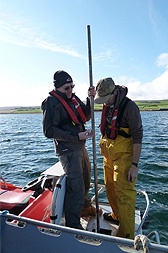- Overview
-

Research to date demonstrates that relative sea-level around Orkney at the start of the Holocene lay some 35m below present. Since then gradual sea-level rise has taken place, and a series of radiocarbon determinations indicate that present sea-level was reached c. 2000 BC. Considerable tracts of land have been submerged since the arrival of the earliest settlers in Orkney.
Work includes geophysical survey, seismic survey, diving, environmental sampling, sediment analysis and dating, ethnoarchaeology, and aerial photography. Since 2009 work has focussed on the Bay of Firth at the heart of the archipelago of Orkney because of its location and topography which offer a classic location for the survival of submerged archaeology. Results include a detailed environmental history of the Bay from dryland valley to marine waters. Over 30 anomalies have been identified most of which represent potential archaeological sites, ranging from the Neolithic to the present day. Work has also taken place in the Loch of Stenness and around the World Heritage Sites of the Heart of Neolithic Orkney, where first indications suggest that prehistoric material may also have been submerged.
- Project Partners
-
- Alastair Dawson, University of Aberdeen
- Richard Bates, Scottish Oceans Institute, University of St Andrews
- Sue Dawson University of Dundee
- Martin Bates and Nigel Nayling, University of Wales, Trinity St David, Dei Huws University of Bangor.
